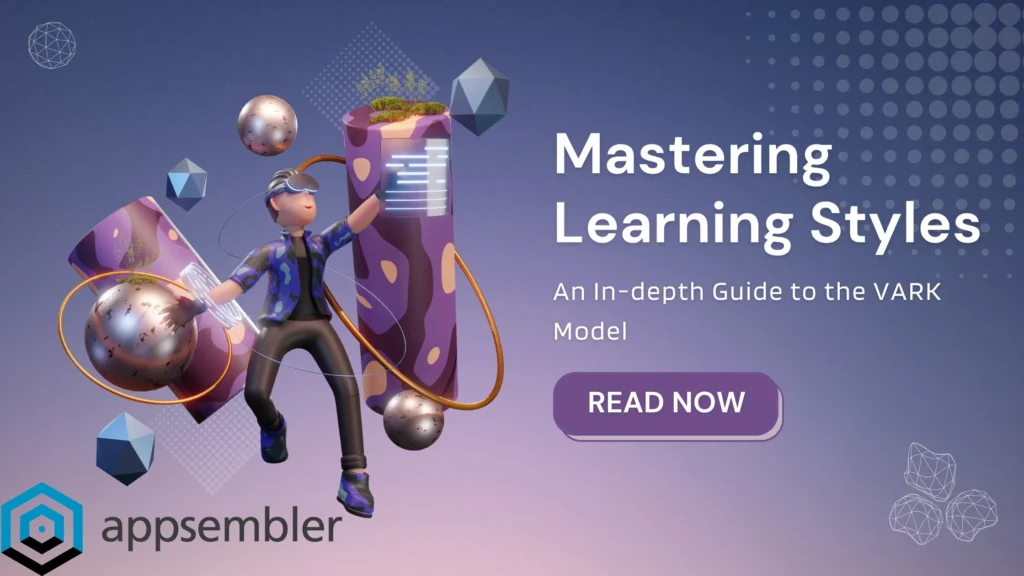In this comprehensive guide, we delve into the VARK model of learning, dissecting its various components and implications. We explore its roots, dive deep into each learning style, and provide valuable insights on applying this model in diverse scenarios.
Key takeaways:
- The VARK model recognizes four primary learning styles: Visual, Auditory, Reading/Writing, and Kinesthetic.
- Identifying your VARK style can significantly optimize your learning process.
- The VARK model is applicable across various scenarios, including academics, professional settings, and personal development.
- The VARK model, while a powerful tool, is not without limitations and criticisms.
- Practical steps on identifying your VARK style and maximizing your learning potential.
Table of contents
- Introduction
- What is Learning?
- Different Learning Styles: An Overview
- Deep Dive into the VARK Model
- Detailed Analysis of the VARK Learning Styles
- How to Identify Your VARK Learning Style
- Appsembler: Enhancing VARK Learning Experiences
- How to Apply the VARK Model in Different Scenarios
- Criticisms and Limitations of the VARK Model
- Conclusion
- Frequently Asked Questions
Introduction
In an era defined by digital transformation, the importance of effective learning systems cannot be overstated. Unleashing the power of Learning Management Systems (LMS) represents an integral step towards realizing the potential of customized educational experiences. Equipped with the ability to cater to individual learning styles, the LMS transcends traditional boundaries of education, providing a pathway to personalized, impactful learning.
Understanding different learning styles, from the traditional visual and auditory approaches to the more kinesthetic methods, becomes vital in creating an effective LMS. Each learner is unique, absorbing and processing information in a manner that’s specific to them. Tailoring the learning environment to suit these diverse styles is a crucial aspect of education, enhancing the learning curve and resulting in better knowledge retention.
Enter the VARK model – an innovative approach to understanding these diverse learning styles. An acronym for Visual, Auditory, Reading/Writing, and Kinesthetic, the VARK model offers an insightful perspective on learner diversity. It serves as a roadmap for educators and LMS developers alike, assisting in the creation of systems that cater to the unique learning preferences of each individual.
Through the lens of the VARK model, an LMS can transform from a standard educational tool into a dynamic learning environment that respects the diversity of its users. Let’s embark on a journey to understand how this transformation takes place and the role that the VARK model plays in optimizing learning experiences in a digitally-driven world.
What is Learning?
At its core, learning is the process of absorbing, comprehending, and applying information to forge new understandings and skill sets. In a broader sense, it’s the continuous journey of personal and professional growth that prepares individuals to navigate the world efficiently.
In the context of a Learning Management System (LMS), a nuanced understanding of learning becomes pivotal. This understanding cultivates the foundation upon which LMS are built, driving their efficacy and influence. Effective learning isn’t merely about retaining facts. It transcends into the realm of practical applications, problem-solving capabilities, and evolving thought processes.
An LMS, equipped with insights from models such as VARK, fosters this higher level of learning, creating environments that are not just repositories of information but incubators for innovation and growth. Thus, learning, in its essence, becomes a dynamic interaction between individuals and systems, leading to the creation of more engaging and efficient educational experiences.
Different Learning Styles: An Overview
As we delve deeper into the dynamics of a Learning Management System (LMS), it becomes essential to unpack the myriad learning styles it supports. Each style, unique in its approach, reflects the diversity of human cognition and provides the cornerstone for designing a truly inclusive and personalized LMS.
The first learning model to consider is the traditional auditory model, where learners assimilate information most effectively through listening. These individuals thrive in lecture-based environments, absorbing spoken content with dexterity.
Next up is the visual learning model, an approach where information is best comprehended when presented in diagrams, charts, or any graphical representation. Visual learners are adept at recognizing patterns and interpreting visual data.
The third model is the read/write style of learning, where learners prefer information in textual format. They engage deeply with written content, extracting knowledge from books, articles, and essays.
Lastly, the kinesthetic model is for learners who grasp concepts best when physically engaged with the learning process. They benefit from hands-on experiences, demonstrations, and practical applications of knowledge.
By harnessing these distinctive learning styles, an LMS can provide a fertile ground for all learners to thrive. This is where the VARK model comes into play, offering valuable insights to shape a learner-centric LMS.
Deep Dive into the VARK Model
The VARK model serves as a beacon in the realm of educational methodologies, guiding the construction of efficient and adaptable Learning Management Systems (LMS). Originating from the ingenuity of Neil Fleming in the late 1980s, the VARK model is the culmination of rigorous research in understanding how humans learn differently.
VARK, an acronym for Visual, Auditory, Reading/Writing, and Kinesthetic, identifies the four primary types of learners. Each letter signifies a distinct style of learning, creating a comprehensive framework for understanding and accommodating diverse learning patterns.
Visual learners, as the name suggests, grasp information best when it’s presented in a visual form such as graphs, diagrams, or charts. They excel in interpreting visual data, making connections, and discerning patterns.
Auditory learners flourish in environments where information is communicated orally. These learners adeptly understand and retain spoken content, from lectures to audiobooks and verbal instructions.
Reading/Writing learners show a pronounced inclination towards text-based information. Whether it’s scholarly articles, textbooks, or written instructions, these learners engage deeply with written words.
Kinesthetic learners, the last type defined by the VARK model, thrive on practical experience. They learn most effectively by doing, moving, and interacting physically with their learning environment.
The VARK model holds paramount importance in education, particularly in the design and deployment of LMS. It provides valuable insights into crafting tailored educational experiences, which cater to the individual learning styles of users. By leveraging the VARK model, an LMS can transform from a one-size-fits-all platform into a customized learning environment that mirrors the unique learning preferences of its users.
From curriculum designers to LMS developers, understanding and applying the VARK model is key to fostering an inclusive and engaging learning ecosystem. It assists educators in presenting information in various formats, thereby facilitating comprehensive learning experiences that appeal to all types of learners. In a digital age characterized by an abundance of information and diversity of users, the VARK model offers a pathway towards a more personalized, efficient, and impactful learning journey.
Detailed Analysis of the VARK Learning Styles
The VARK model is the gateway to understanding the myriad ways learners assimilate information. With an effective Learning Management System (LMS), one that respects and accommodates these diverse styles, the learning process becomes a vibrant, customized journey. Let’s delve deeper into each of these styles to truly comprehend their unique characteristics and techniques.
Visual Learning Style
Visual learners think in pictures. They prefer to view information in a graphical format, using imagery to interpret, understand, and retain data. Charts, diagrams, infographics, and mind maps often prove invaluable for these learners. They can quickly identify patterns, connections, and details that may elude others. By incorporating more visual elements, an LMS becomes a haven for visual learners, enabling them to engage with content in their preferred mode.
Auditory Learning Style
Auditory learners are masters of the spoken word. They are able to listen, comprehend, and retain information with high efficiency. Listening to lectures, participating in discussions, and engaging with audio books or podcasts are common techniques for auditory learning. An LMS can optimize for auditory learners by providing quality audio content, interactive discussions, and perhaps even integrating with podcast platforms or other audio resources.
Reading/Writing Learning Style
Reading/Writing learners thrive on textual content. They interact deeply with written words, using text as their primary tool for comprehension and retention. Taking notes, reading textbooks, writing essays, and even rewriting notes are some techniques these learners use. In a well-designed LMS, there should be a wealth of textual content available, and tools for note-taking, essay writing, and text-based discussion can make the platform highly engaging for these learners.
Kinesthetic Learning Style
Kinesthetic learners learn by doing. They need to physically engage with the material, be it through experiments, simulations, or role-playing. Practical application and tactile engagement is key for these learners. An LMS that includes interactive simulations, virtual labs, and hands-on assignments can be an excellent learning environment for kinesthetic learners.
In sum, the VARK model offers a multi-faceted lens through which we can view learning styles. By understanding and catering to these styles, an LMS transcends from a mere information delivery system to a vibrant learning environment. It becomes a conduit for tailored learning experiences, fostering growth, engagement, and satisfaction among its diverse users. Embracing the VARK model, thus, isn’t just a pedagogical choice; it’s a commitment to creating a holistic, inclusive, and dynamic learning ecosystem.
How to Identify Your VARK Learning Style
Identifying your unique VARK learning style is akin to acquiring a compass in the vast landscape of education. It directs you towards your most effective learning pathways, enhancing comprehension, engagement, and retention. But how can you determine your specific learning style?
The journey begins with introspection. Reflect on the ways in which you naturally gravitate towards receiving and processing information. Do you find it easier to understand concepts when they’re explained in a visual format? Perhaps you prefer reading text, or maybe you learn best when you’re physically involved in the process. These preferences provide valuable clues to your predominant learning style.
However, for a more objective analysis, taking a VARK questionnaire can be highly beneficial. These questionnaires are designed to gauge your learning preferences through a series of situational questions. By analyzing your responses, you can determine whether you’re a visual, auditory, read/write, or kinesthetic learner.
Knowing your VARK learning style can have a profound impact on your educational journey. It equips you with the knowledge to tailor your study methods, aligning them with how you naturally learn best. This personalized approach boosts comprehension, increases retention, and makes learning a more enjoyable experience.
Furthermore, being aware of your learning style empowers you to communicate your learning preferences effectively. Whether you’re interacting with instructors, peers, or even a Learning Management System, this understanding can help optimize your learning environment.
In conclusion, identifying your VARK learning style is not just an exercise in self-awareness. It’s a strategic move towards personalizing your learning experience, maximizing your potential, and truly making the most of the educational opportunities at your disposal.
Appsembler: Enhancing VARK Learning Experiences
At the intersection of technological innovation and pedagogical research lies Appsembler, a leading Learning Management System. The platform excels in creating personalized learning environments, which truly resonate with the principles of the VARK model.
Appsembler, acutely aware of the diverse learning styles, leverages its robust platform to cater to each style. For visual learners, the platform supports the integration of a rich variety of visual content, including diagrams, infographics, and video material. Auditory learners benefit from its audio content features, while the abundance of text-based resources cater to reading/writing learners. Lastly, for kinesthetic learners, the platform includes interactive tasks, simulations, and practical projects that fuel their hands-on learning needs.
Moreover, Appsembler extends its commitment to VARK principles by aiding users in identifying their unique learning styles. It offers a suite of tools designed to glean insights from learners’ interactions with the platform. These insights help pinpoint the type of content and tasks with which users engage most effectively, suggesting their probable VARK learning styles.
Armed with these insights, Appsembler helps optimize the learning experience. It encourages users to leverage content that aligns with their identified learning styles, creating a more personalized and efficient educational journey.
By seamlessly blending the VARK model with its platform’s capabilities, Appsembler exemplifies how technology can enhance learning experiences. It affirms that with the right tools and insights, education can become a truly personalized and engaging endeavor.
How to Apply the VARK Model in Different Scenarios
The VARK model isn’t confined to classrooms or Learning Management Systems. Its value extends into every scenario where learning occurs. Whether it’s academic, professional, or personal development settings, the VARK model offers a powerful framework for enhancing learning experiences.
In academic settings, the VARK model provides a roadmap for individualized learning. Educators, aware of students’ varied learning styles, can design lessons that cater to each style. By incorporating visual aids, audio content, text-based materials, and hands-on tasks, they can ensure the content resonates with every student. Likewise, students, empowered with the knowledge of their learning styles, can tailor their study methods for optimal comprehension and retention.
Professional settings, too, can gain significantly from the VARK model. In the context of training and development, understanding employees’ learning styles enables the creation of effective training programs. For instance, visual learners may benefit more from graphic-rich presentations, while kinesthetic learners may thrive in interactive workshops. By applying the VARK model, companies can improve the effectiveness of their training, leading to enhanced performance and productivity.
For personal development, the VARK model is a tool for self-directed learning. It assists individuals in identifying their preferred learning styles and tailoring their learning strategies accordingly. Whether it’s learning a new language, a musical instrument, or a tech skill, aligning the learning process with one’s VARK style can make the journey more enjoyable and successful.
In essence, the VARK model serves as a bridge, connecting learners with the methods that work best for them. It brings awareness to the diversity of learning styles and promotes an inclusive, efficient, and engaging approach to education in all its forms.
Criticisms and Limitations of the VARK Model
The VARK model, while an impactful tool in understanding learning preferences, is not without its criticisms and limitations. A prominent criticism lies in its oversimplified categorization of learners into four distinct types. Learning is a complex process and may not be fully captured by a four-category model. It’s possible that individuals exhibit tendencies of more than one learning style, or their preferences change based on context or content.
Additionally, some argue that tailoring instruction to individual learning styles may not necessarily lead to improved learning outcomes. It’s important to remember that the VARK model is about preference, not ability. A preference for visual learning does not imply an inability to learn through auditory or kinesthetic methods.
As for misconceptions, it’s vital to remember that the VARK model is a tool for understanding learning preferences, not a rigid instructional guide. It should not be used to pigeonhole learners into a single style, but rather as a way to diversify instruction and respect the diverse ways learners engage with content.
Despite these criticisms, the VARK model offers valuable insights into learning preferences. Its application can encourage more inclusive, diversified, and learner-centered environments, promoting an engaging and effective learning experience.
Conclusion
The VARK model unravels the intricacies of individual learning preferences, spotlighting the importance of a personalized approach in education. From academics to professional training and personal development, it has demonstrated its transformative potential. Although not without limitations, the model acts as a catalyst for creating diversified, inclusive learning environments.
Platforms like Appsembler elevate this approach, offering tools to both identify and optimize these learning styles in a digital environment. It empowers learners and educators alike to align their efforts with individual learning preferences, driving engagement and effectiveness.
In conclusion, embrace the VARK model’s insights. Discover your unique learning style and use it to optimize your educational journey. Remember, learning is not a one-size-fits-all process, but a personalized journey that evolves with you.
Frequently Asked Questions
The VARK model is a framework for understanding an individual’s learning style. The acronym VARK stands for Visual, Auditory, Reading/Writing, and Kinesthetic, representing the four different types of learning preferences.
The VARK model impacts learning by highlighting the importance of individual learning preferences. By understanding a learner’s VARK style, educators can tailor their instruction methods and content, while learners can optimize their study strategies for improved comprehension and retention.
The role of the VARK model in education is to provide a roadmap for individualized learning. It helps educators design lessons that cater to different learning styles and helps students tailor their study methods for more effective learning.
Appsembler, a Learning Management System, aligns perfectly with the VARK model principles. It offers a suite of tools to cater to different VARK learning styles and helps users identify their preferred learning style for a more personalized and efficient educational journey.
Criticisms of the VARK model include its oversimplified categorization of learners into four distinct types. Some argue that it does not fully capture the complexity of learning, as individuals may exhibit tendencies of more than one learning style, or their preferences may change based on context or content.
You can identify your VARK learning style through a self-assessment process, where you reflect on the methods in which you best understand and retain information. Tools like Appsembler can also assist in this process by analyzing your interactions with different types of content.
You can apply the VARK model to your personal learning by identifying your preferred learning style and tailoring your study strategies accordingly. For instance, if you’re a visual learner, try to incorporate more visual aids like diagrams or charts in your study materials.
Yes, there are limitations to the VARK model. It does not account for the complexity of learning and the possibility that learners can exhibit tendencies of multiple styles or that preferences can change based on context or content. Also, a preference for a certain learning style does not imply an inability to learn through other methods.
Appsembler plays a significant role in enhancing VARK learning experiences by offering a rich variety of content that suits different learning styles and providing tools to identify and optimize these learning styles, thereby ensuring a more personalized and efficient educational journey.
In professional settings, you can apply the VARK model in training and development programs. Understanding employees’ learning styles enables the creation of effective training programs that cater to each style, thereby improving the effectiveness of training and productivity.



